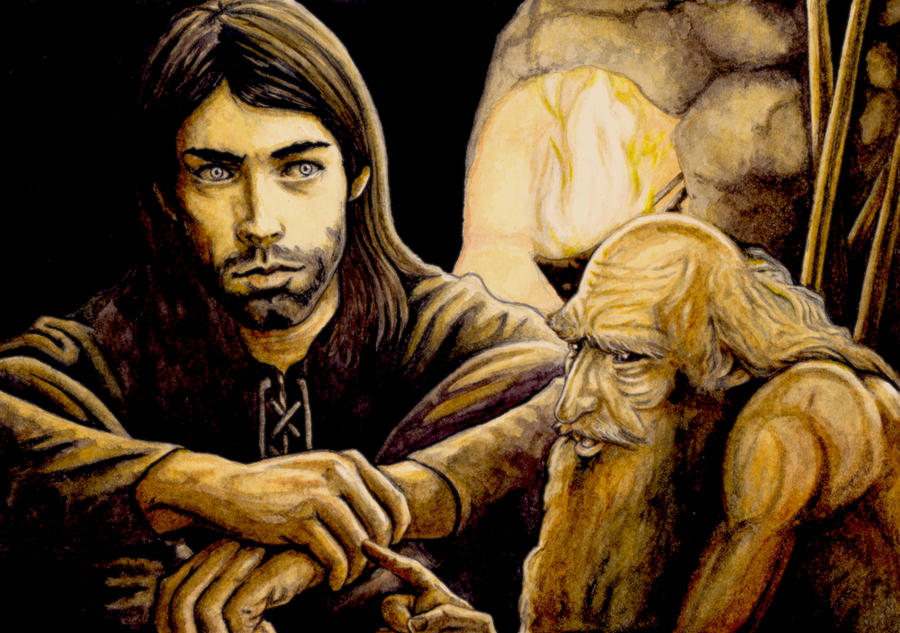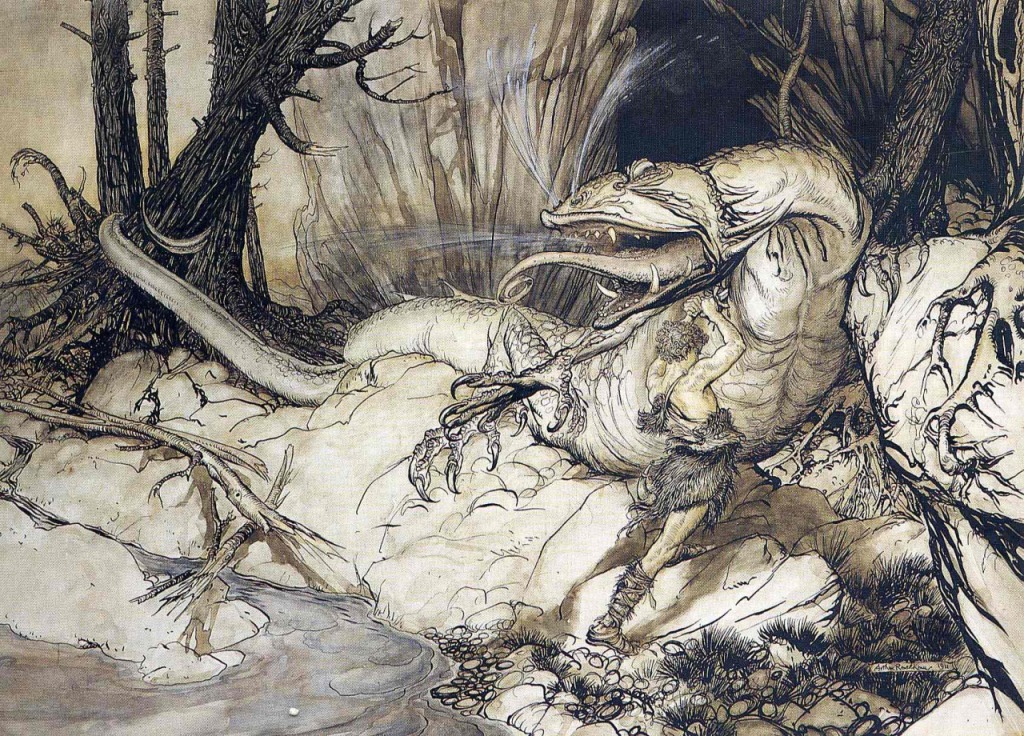The next section in Tolkien’s Sigurd story continues with Volsung, Sigmund, and Signy. King Volsung is a son of Odin, and so we can see Odin setting up the line of the Volsungs to continue with the birth of Sigurd. An interesting note to this meddling in the affairs of the world occurs during Signy’s marriage to Siggeir, setting the stage for Odin to come disguised as the hooded, one-eyed man Grimnir, as he thrusts his sword into the tree in the middle of the hall. (Also an ancient sword in the stone motif here). And because Sigmund is the only one who can pull it out, Siggeir’s jealousy – as essentially Sigmund kind of stole the day from him as it was his wedding- lays the foundation for the betrayal and killing of the Volsungs. But this is all part of Odin’s plan, and he chose Sigmund in this.
When they battle in Gautland, King Volsung is struck down, and Odin can then take him to Valhol, just as he intended. But an interesting part of this story that Tolkien doesn’t embellish on is when Siggeir has captured Signy’s nine brothers and tied them up in the woods. Each night a wolf eats one of the brothers, but when the servants go to see what happened to them,
Signy: “What found ye in the forest,
my fair servants?”
Servants: “Nine brothers’ bones
under night gleaming:
yet were shackles broken,
she-wolf lying
torn and tongueless
by the tree riven” (82).
Sigmund has escaped from his shackles and killed the wolf, and after, he goes into hiding. The next part is more explicit, where Signy disguises herself as an elf maiden comes to the cave where Sigmund is hiding and commits incest with him. All to have a pure bred Volsung to continue the line.
Brother and sister
in a bed lying,
brief love, bitter,
blent with loathing! (83)
Later, she sends their son Sinfjiotli to him, and together they get revenge on Siggeir in the shape of wolves. As Siggeir’s hall is burning, Signy tells them that they are father and son, and then she enters the burning building to commit suicide.
In the Saga of the Volsungs, there’s a lot more to this story. Again, Odin comes to Volsung’s hall and lodges the sword into the tree, Sigmund retrieves it, and Siggeir plots revenge. Volsung is killed in the battle, and his sons are tied up in the woods. The she-wolf comes and kills nine of the brothers. But Signy’s plan is to smear honey all over Sigmund’s face and in his mouth so when the wolf comes for Sigmund and she puts her tongue in his mouth, Sigmund can tear her tongue out and kill her.
As usual the same she-wolf came in the night, meaning to bite Sigmund to death as she had his brothers. But then she caught the scent of the honey that had been rubbed on him. She licked his face all over with her tongue and then reached her tongue into his mouth. He did not lose composure and bit into the wolf’s tongue. … But Sigmund held on so tightly that the wolf’s tongue was torn out by the roots, and that was her death (41-42).
This, then, is the background that Tolkien is working with, but it’s episode that maybe doesn’t need to be expounded upon, only that Sigmund is able to escape, and maybe not important to the overall theme of Odin’s workings in the fate of men. But it’s an interesting scene that Tolkien doesn’t use. Neither does he include the part in the Saga of the Volsungs where Signy sends her first two sons to Sigmund, before she commits incest with him, and where Sigmund tasks them with making bread, but he has put a snake within the flour to test their resolve. These two sons are too afraid to make the bread, so Sigmund kills them. And so does Tolkien, in a sense. But this is when Signy comes to Sigmund in the shape of a sorceress and Sinfjotli is born, where then he is given the same task and does it with ease by kneading the snake into the dough.
Then Sigmund asked if he had discovered anything in the flour. “I am not without suspicion,” he said, “that there was something alive in the flour when i first began kneading, but I have kneaded it in, whatever it was.” … Sigmund was so hardy that he could eat poison with no ill effect. Sinfjotli, however, although he could tolerate poison externally, could neither eat nor drink it (43-44).
Again, maybe not super important to the story in the way Tolkien is being very succinct in his storytelling and throwing out the not so necessary parts. But after, Sigmund and Sinfjotli take revenge on Siggeir, and Sigmund marries Borghild and has two other sons with her, Helgi and Hamund.
More importantly for Tolkien is the next part, “Daudi Sinfjotla,” Sinfjotli’s untimely death at the hands of Sigmund’s wife Borghild. Tolkien’s version has her poison his drink because Sinfjotli killed her father in battle. Twice she gives him the poison and Sigmund drinks it for him. The third time, she taunts him, and Sinfjotli drinks the poisoned ale and dies.
Queen: “Ale I offer thee,
eager Volsung!
Volsungs valient
at venom blench not;
heroes ask not
help in drinking –
if thou darest,
drink Sinfjotli!”
Dead Sinfjotli
drinking stumbled (90).
Sigmund then brings his body to the shore to the Boatman, who happens to be Odin, and so Odin has another warrior to use for the last battle at Ragnarok. Fate orchestrating it so that Sinfjotli dies, that Sigurd can be born.
The Poetic Edda also has a section specifically for the death of Sinfjotli called “The Death of Sinfiotli,” which is just a prose account, and is basically the same as the Saga of the Volsungs. The difference from Tolkien’s version is that Sinfjotli kills Borghild’s brother who was wooing the same woman as him. Again, she poisons his drink three times, Sigmund drinking it the first two times. The third time, Sigmund tells Sinfjotli, “Let your mustache strain it, son!” (138). Because, as it says in the Saga of the Volsungs, “The king was quite drunk, and therefore he talked in this way” (51). Obviously, a ridiculous notion that Tolkien axes in his version that doesn’t make sense in real life nor for his storytelling purposes. But in the end, Sigmund brings his body to the boatman, and he’s taken away.
Works Cited
The Poetic Edda. Translated by Carolyne Larrington, Oxford University Press, Revised Edition, 2014.
The Saga of the Volsungs. Translated by Jesse. L. Byock, Penguin Books, 1999.
Tolkien, J.R.R. The Legend of Sigurd and Gudrún. edited by Christopher Tolkien, Houghton Mifflin Harcourt Publishing Company, 2009.




